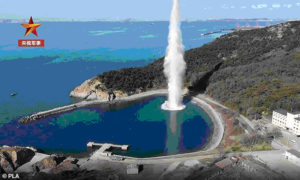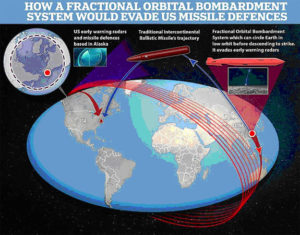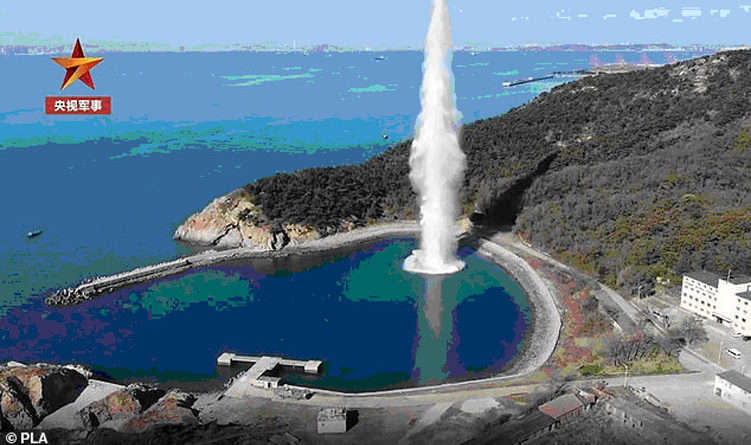China Carries Out First Successful Test Of Underwater Explosives After Launching ‘Satellite-Crushing’ Weapon And Hypersonic Missile
27 October 2021
- China has carried out its first test of underwater explosives to destroy a port
- Test was used to gather data that can be used for demolitions during a real war
- Underwater bombs could be used to target US ports in conflict, state media said
- Comes after China launched satellite that could crush other spacecraft, and tested what analysts believe to be two hypersonic orbital nukes
China has carried out its first-ever demolition of a port using underwater explosives, a tactic that state media said could be used against the US in the event of a war.
Beijing’s military carried out the test on Saturday, using underwater charges to destroy a dummy wharf at an undisclosed location somewhere in China.
The technology is designed to cut off enemy supply lines in the event of a conflict, state-owned Global Times newspaper said, adding that sneak attacks using underwater charges will make large vessels like US aircraft carriers vulnerable.
It is just the latest in a string of Chinese military tests – including the launch of a satellite last week that the US warns could attack other spacecraft, and two tests of an orbital weapon that analysts think is a hypersonic nuke.

China has successfully tested underwater explosives to destroy a port, which state media says will be used to destroy American logistics networks in the even of a real war
Reporting on the latest test, Global Times said underwater charges were used to ‘fully demolish’ a wharf with a ‘powerful explosion’.
Sensors installed on the wharf were used to gather data that will be used to support attacks on ‘hostile ports in a real war,’ the Times said.
It added that underwater demolitions are a response to changing US tactics in the Pacific, claiming that Washington is dividing its forces between smaller locations instead of concentrating them in one place to mitigate the damage from attacks.
This tactic increases the strain on logistics operations required to keep large vessels such as aircraft carriers afloat, the Times said, making attacks on infrastructure such as ports and wharfs more important.
‘With ports destroyed, enemy logistics support will fail and a dispersed fighting force… will also fail,’ an unnamed military expert told the paper.
The test comes just a day after the Times reported on the launch of a new satellite – Shijian 21 – which the paper said is designed to test technology to clear space debris.
But Washington warns the same technology – thought to take the form of a robotic arm – can be used to ‘grapple’ other satellites and potentially disable them.
Beijing has launched one ‘debris-clearing’ satellite before – Shijian 17 – which went into space back in 2016.
Officially designated a communication satellite that is merely ‘observing’ space debris, the US says it is actually equipped with a robotic arm.
Washington argues that Shijian 17 is in fact a military satellite that is capable of bringing down other orbiting craft.
General James Dickinson, head of US Space Command, wrote to Congress earlier this year that the satellite ‘could be used in future for grappling other satellites’ and is aimed at achieving ‘superiority through space-attack systems’

China launched the Shijian 21 satellite into orbit on Sunday (pictured), saying it will test technology to clear space debris – the same tech the US warns can destroy other satellites

China is thought to have carried out two tests of a hypersonic orbital nuke – the first on July 27 and the second on August 13 this year. Observers believe the ‘weapon’ is an updated version of a Soviet concept called a ‘Fractional Orbital Bombardment System’, or FOBS. It is designed to evade powerful US radar systems and anti-missile defences designed to shoot down traditional ICBMs by flying in low-Earth orbit, making it harder to spot, track and destroy
The satellite launch follows two tests over the summer of what intelligence analysts believe is a new kind of hypersonic orbital nuke.
Beijing is believed to have tested the weapon in July and again in August. The tests were only revealed last week after intelligence sources leaked the information.
Those charged with assessing the new ‘weapon’ are still struggling to work out exactly what it is capable of, buy say it appears to ‘defy the laws of physics’ and goes beyond anything the US has developed.
The craft that China launched orbited the Earth at high speed before coming down on a target which it missed by some 24 miles, analysts said.
Based on that information, it appears to be similar to a Cold War-era Soviet nuclear system called FOBS which is designed to evade defence systems.
Beijing has acknowledged one of the tests, but denies it launched a weapon and says the craft was actually for civilian use.
Earlier this week, Xi Jinping urged Chinese scientists to ‘break new ground’ in developing weapons to create a ‘world class’ army.
China’s military budget has been growing year-on-year since the 1990s in line with its booming economy.
When Xi took over leadership of the country in 2012, it stood at roughly $130billion. Back in March, the 2021 budget was revealed to be almost $210billion.
That extra cash has been used to build the country’s first aircraft carriers, with nuclear-powered ones now in the works.
China has also churned out new tanks, stealth fighter jets, long-range bombers, missiles and drones.
Courtesy: Mail Online

